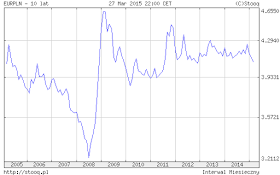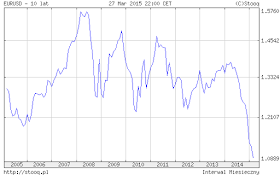The recent weeks brought some noteworthy developments on financial
markets, some particularly worth highlighting and commenting on. Observations
of how markets behave leads me to conclude my academic grasp of economic
theorems is being rendered obsolete, while new paradigms unfold…
1. Interest rates
In early
March Poland’s monetary authorities decreased the policy rate by 50 basis
points, to (yet another) record-low 1.50%. In terms of historical levels of
central bank’s rates, the current level appears hazardously low, however put
into broader perspective, Poland’s monetary policy does not come out as
extremely easy. Absolute level of interest rates is among the highest in the EU
and oddly enough, real interest rates have not been that high since many years.
Current real rate is around 3% (1.50% policy rate + 1.60% y/y deflation), while
in the past years inflation-adjusted interest rates would not seldom run into
negative territory. Do notice this reasoning bears some simplification, since
inflation records are backward-looking while interest rates as of today refer
to future periods and time mismatch exists.
The Polish
central bank’s governor has also stressed there was no room for further
monetary easing and over the coming months monetary authorities would take the
“wait and see” approach. The only justification for such scale of monetary
loosening is the ongoing deflation, which however is spurred by factors beyond
central bank’s control. By slashing interest rates to record-low levels the
central bank only adjusted its policy to evolution of price level in the
economy (the question remains whether NBP would be capable of swiftly reacting
to increasing inflation). Lower interest rates will not kick-start the economy,
as it is expanding in a healthy and sustainable pace, consumption will also not
be much stimulated, since propensities to spend, save and borrow are driven by
several other more meaningful factors than monetary policy. Consequently, the
most aggrieved by the recent rate cut are depositors whose savings do not grow
as fast as they would like to be.
The other
group hit are banks. They “suffer” (i.e. fall short of their shareholders’
expectations towards profits reaped in Poland) because rate decrease is
followed by drop in cap on interest rates they are allowed to charge borrowers
which is 4 times central bank’s lending rate, now 4 times 2.50%, i.e. 10%.
Evidently banks find several ways of circumventing the regulation. Quite
recently I learnt an up-front fee for a cash loan is on average 10% these days.
In practice it means if you want to borrow let’s say 10,000 PLN you either
effectively have to borrow 11,000 (and pay interest on it) or effectively get
only 9,000 (but pay interest on 10,000). Banks will pass the unfavourable
impact of monetary policy to their clients, as they will do with an increased
deposit insurance fund contribution. The fund, intact between 2001 and 2014,
has been recently depleted by 3 billion PLN to fund payments to depositors who
had entrusted their money to insolvent credit unions (since October 2012
covered by deposit insurance system and the same rules of financial supervision
as banks). The fraudulent activity of credit unions has been harnessed for
full-blown mud-slinging in the current presidential campaign, yet this is a
topic for another post…
Worth also
mentioning the financial watchdog issued a warning to banks against evaluating
mortgage loan applicants creditworthiness based on current interest rates and
show clients stress simulations, i.e. how their instalments would rise if
interest rates increased by a specific number of basis points. A commendable
move, given currently granted mortgage loans could turn out to be a time bomb
akin to CHF-denominated mortgages foisted upon client when the Swiss France
cost not much above 2 PLN. Seven years ago Polish central bank’s policy rate
was 6%. Unless a new paradigm emerges (i.e. interest rates higher than zero
being an abnormal phenomenon), return of interest rates to such level within 25
or 30 years when mortgage loan is to be repaid, is definitely conceivable.
2. Stock
market
Since
taking up the job with the New Factory I am subject to stringent restrictions
on trading, hence in order to avoid requesting approval for each single
transaction, reporting transactions ex-post after each trade, reporting not
executed trades and submitting breakdowns of orders and transactions at the end
of each reporting period, I terminated my brokerage account and spare myself
adrenaline by putting all my money into saving accounts and term deposits.
WIG, the
broad market index covering almost the entire universe of stocks listed on
Warsaw Stock Exchange, performed quite well in the first quarter of this year.
It must be noted this index is a total return index, i.e. takes into account
dividend income, in contrast to for instance WIG20, covering 20 biggest in
terms of market capitalisation companies on WSE.
For this
index I deliberately have chosen 10Y time interval for comparison, to
illustrate for over two years the index has been in a clearly sideways trend.
WIG20 is a price index, hence its readouts fail to reflect dividend income
distributed to shareholders, which may make up a large portion of income, since
many of index’s components are state-controlled cash cows whose dividends are a
vital source of money to the government budget. Yet the chart clearly indicates
those who invested in the index portfolio four years ago might not have broken
even, even despite reaping several generous dividends.
Conclusions:
the discrepancy between broad-market WIG index and blue-chip WIG20 index
reflects not only differences in calculation formula but also the fact smaller
companies outperform larger. WIG is hence a better business cycle gauge, yet
not only because of its width. WIG20 composition is quite specific and not
well-diversified. Banks have a large weight in the index, besides mining, oil
and gas and electricity are strongly represented in the WIG20, making the index
undesirably reliant on sentiments in a few industries and to regulatory and
market environment having substantial impact on earnings of companies
underlying the index.
3. Currency
market
USD/PLN,
here the pair purposely presented over 10Y horizon, has recently hit its
10-year high of 3.95 (some 0.05 higher than in memorable February 2009). The
psychological barrier of 4.00 has not been even neared. Unlike six years ago,
it was not the weakness of Polish zloty, but the strength of the US currency
that drove USD/PLN quotations to exorbitantly high levels.
Polish
currency recently has been amazingly stable as never before in its history
which is well illustrated by EUR/PLN quotations. For more than two years,
EUR/PLN has not broken out of quite narrow range from 4.00 to 4.30, while most
of the time it stayed between 4.10 and 4.20. Such volatility is characteristic
for mature markets. What also needs to be underlined, level on which the
exchange rate has stabilised is neutral for the Polish economy, i.e. it well
strikes balance between ensuring competitiveness of Polish exports and fending
off prohibitive prices of imported goods. The issue of EUR adoption in Poland
is also intensively exploited in the presidential campaign.
The
divergence between skyrocketing USD/PLN and fairly stable EUR/PLN must lie on cross
pair, EUR/USD. Quotes of the most liquid currency pair in the world dropped for
a moment below 1.05 in the second week of March, thus also hitting 10Y low and
then bounced back, yet remain below 1.10. The quaint FX rate movement reflects
relative strength of the US economy and imminent monetary tightening (although
Fed’s declaration interest rates will not be jacked up very soon brought
appreciation of USD to a halt) as well as doldrums in which the EU economy is,
compounded by increased scale of quantitative easing pursued by the ECB.
And for the
very end, CHF/PLN quotations for which in my view the most relevant period for
observation is three months. After shooting up on 15 January 2015, the Swiss
currency slowly depreciated and CHF/PLN levelled off around 3.90, some 8%
higher than before the SNB spun its currency out of control. For the indebted
in CHF, impact of rising CHF/PLN has been well offset by negative LIBOR
(currently near –0.85%) Polish banking sector’s concerted spread decrease
(banks have not done it off their own bat, but have been coerced by financial
sector watchdog). Mortgage debts of many households are now some 8% higher than
in late 2014, yet their monthly debt service cash flow has not been hit.
4.
Commodities
For sake of
brevity I will focus only on crude oil prices that were searching for trough in
second and third decade of January 2015. The subsequent rebound was a typical
reaction of speculators to clearly oversold market. The scale of incline in the
first half of February 2015 was impressive, since Brent oil price went up by
some 30% within two weeks. In March oil quotations were very volatile, best
proven by price fluctuations over the last two trading days. On 26 March oil
went up by 5% in the wake of news of military action in Yemen to retreat by 5%
on 27 March and wipe out almost the whole price increase from the previous day.
The
question which naturally comes up these days is where the markets are heading.
The only answer that naturally comes up to my mind is “I have no idea”. The most
intensive period of my study of economics fell into 2008-2010, the run-up to
the financial crisis, its most severe phase and early recovery. Near-zero
interest rates at that time were considered a temporary measure employed to
buoy up economies. Today, after six and a half years of ultra-loose monetary
policies and no prospect of returning to long-term average levels of interest
rates in developed economies one should ask what the current level of neutral
interest rate in Taylor rule equation is.
I cannot
even tell you in which phase of the traditionally defined business cycle we
are. In Poland in 2000s we could witness recovery, early upswing, late upswing
and downturn, in second half of 2009 we saw recovery, late upswing was in 2011,
then the Polish economy slowed to record sluggish growth in 1Q2013. Are we now
in early upswing or in late upswing? Needless to say, with hindsight it is
easier to judge. But if we bear in mind stock market is said to be good
indicator of future trends in the economy and it has been flat or mildly rising
in the past months, economic growth should slightly accelerate. Economists’
forecasts in unison foresee a period of flat, but stable growth of 3% - 4%
until 2017. Overly optimistic? Economists’ dreams of smoothed out business cycle
fluctuations coming true? Time will only tell. One thing I am pretty sure of is
that there might be many external shocks which may shatter all plausible
projections. Keep the faith though.









No comments:
Post a Comment